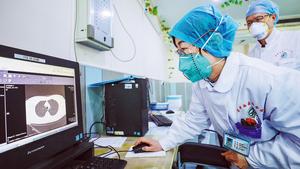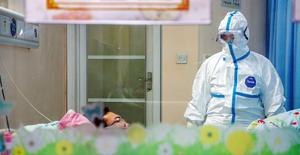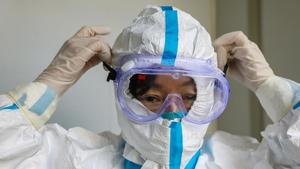Zhang Jixian, a doctor on the front line of the battle to contain the epidemic, was among the first to identify the symptoms of the novel coronavirus in Wuhan and alert the authorities to its potency, Yang Yang reports.
 Zhang Jixian, director of the Department of Respiratory and Critical Care Medicine of Hubei Provincial Hospital of Integrated Chinese&Western Medicine, looks at a patient's CT scan at the hospital in Wuhan, Hubei province, on Jan 30. (YUAN ZHENG / FOR CHINA DAILY)
Zhang Jixian, director of the Department of Respiratory and Critical Care Medicine of Hubei Provincial Hospital of Integrated Chinese&Western Medicine, looks at a patient's CT scan at the hospital in Wuhan, Hubei province, on Jan 30. (YUAN ZHENG / FOR CHINA DAILY)
On Dec 26, 2019, 54-year-old Zhang Jixian, director of the Department of Respiratory and Critical Care Medicine of Hubei Provincial Hospital of Integrated Chinese& Western Medicine, received an elderly couple. Both of them had a high fever and coughed, looking like they had been hit by a normal case of the flu. However, when she checked the CT scans of their lungs, she found something unusual.
Normally, pneumonia causes a pathological change to one of the lungs, but the scans showed that the two elderly people each had ground-glass opacity in both, which was something Zhang had never seen before.
Examinations ruled out common viruses such as influenza A and B, mycoplasma, chlamydia, and adenovirus. Zhang's thoughts turned to SARS, or severe acute respiratory syndrome, that she fought 17 years ago. At that time, her daily work was to investigate suspicious cases in the hospitals of Wuhan's Jianghan district. But, the symptoms displayed by these two new patients were different from those of SARS.
Highly alert to the situation, she asked if the couple had other family members. Their son came. Although he appeared healthy, CT scans of his lungs also showed ground glass opacity.
"Usually, unless it's infectious, a whole family won't get the same disease," she said in an interview with the Global People magazine.
Uncertain about the causes, Zhang decided to admit them into hospital. On the same day, another patient, a seller from Huanan Seafood Market, reported the same symptoms and examinations also ruled out common viruses.
"China's Law on Licensed Doctors requires us to report diseases of unknown causes," said Zhang in a previous interview with China Central Television. The next day, she reported the four cases to the hospital authorities, who immediately informed the center for disease control and prevention of Jianghan district of Wuhan.
 Zhang inspects a novel coronavirus patient in an isolation ward at the hospital. (YUAN ZHENG / FOR CHINA DAILY)
Zhang inspects a novel coronavirus patient in an isolation ward at the hospital. (YUAN ZHENG / FOR CHINA DAILY)
In the following two days, Zhang and her colleagues received three more patients, all with the same symptoms, and all from Huanan Seafood Market. On Dec 29, Zhang reported the situation to hospital authorities. The hospital hosted a consultation, which decided that the disease was truly unusual. They also found two similarly-affected patients in two other hospitals, whose addresses were listed as Huanan Seafood Market too.
The Hubei Provincial Center for Disease Control and Prevention immediately sent experts to investigate the seven patients at the Hubei Provincial Hospital of Integrated Chinese & Western Medicine. Six patients were transferred to Wuhan Jinyintan Hospital, a designated hospital for infectious diseases. The elderly couple's son, insisting on staying, was cured and discharged on Jan 7.
In the early morning of Jan 1, Huanan Seafood Market was shut down. It was the start of the new year, and 23 days later, it would be the Spring Festival. The traffic flow would be huge, because tens of thousands of people would be shopping for the festival.
"Things would have been much worse if the seafood market was not shut down," Zhang says.
"I'm happy that I did the right thing."
On Feb 6, Zhang was rewarded by Hubei's human resources and social security department and the province's health commission for being the first person to report the infectious disease to the government.
Yao Aidong, director of the medical examination center with Zhongnan Hospital of Wuhan University, Zhang's university classmate, said that Zhang worked very hard at university, and was fully devoted to her work.
"She used every opportunity to analyze difficult diseases with classmates, even at reunion parties, so we are not surprised at all that it was her who noticed the disease and reported it to the government," she says.
Apart from reporting the situation to the authorities, Zhang immediately isolated an area with nine beds in her department's 45-bed ward for patients with the unknown disease. Since receiving the elderly couple and their son, Zhang required all her colleagues in the department to wear facial masks. When they entered the isolation area, they would put on N95 masks supplied by the hospital. She also asked her colleague to buy 30 sets of white canvas work clothes online, which arrived on Dec 31.
"If we had applied for protective suits, the ordering process would have been slower," Zhang says.
"Anyway, another layer of clothes gave us more protection."
 The doctor wears protective gear before entering the isolation ward. (YUAN ZHENG / FOR CHINA DAILY)
The doctor wears protective gear before entering the isolation ward. (YUAN ZHENG / FOR CHINA DAILY)
Zhang and her colleagues wore the canvas clothes beneath their doctor's coats and nurse's tunics until Jan 20, when experts announced that the novel coronavirus could be spread by people and the hospital equipped them with protective suits.
To prevent other patients from becoming infected, Zhang and her colleagues managed to persuade them to leave the hospital. Before the large-scale outbreak of the pneumonia caused by the novel coronavirus, no medical workers were infected in Zhang's department and no cross-infection was recorded among their patients.
After the six patients were transferred to Jinyintan, more patients with similar symptoms came, so that, on Jan 1, the isolation ward was full. During the New Year holiday, patients at respiratory and critical care departments increased drastically, from 100 per day to 230 per day. More patients shared the same symptoms as the first seven cases.
On Jan 17, the inpatient department was transformed into an isolation area. Two weeks later, the hospital was designated as one of those specifically equipped to treat the pneumonia caused by the novel coronavirus. The hospital was divided into six parts, with a total of 160 beds.
As the director of her department, Zhang looked after the most severe patients, but would help her colleagues during busy periods.
"Since the end of December, there has not been a break. We work from morning to night without much sense of time. After work, we go directly to bed," Zhang says.
It takes half an hour to take off the protective suits. There are a total of 27 steps, during which hands need to be sanitized 12 times. After doctors use toilets, they need to put on new protective suits, of which there is a shortage. As a result, in order to save time and to manage the use of the limited number of protective suits, doctors and nurses wear adult diapers, and try to drink and eat as little as possible during their shift. Despite carefully taking all the precautions, some of Zhang's colleagues became infected due to their prolonged exposure to a large number of patients.
Over the past month, Zhang revealed she had burst into tears several times. Sometimes, it was because patients suddenly turned critically ill and died despite all of her best efforts. Sometimes, it was because the supply of N95 facial masks and protective suits ran critically low. Sometimes it was just because she saw how hard her colleagues were working.
"Too many patients. It's such a hard time for my colleagues," she says.
"Everybody is trying their best."
As Huoshenshan (Fire God Mountain) Hospital and Leishenshan (Thunder God Mountain) Hospital opened their doors, with a joint capacity of 2,500 beds for criticallyill patients, and three emergency hospitals were also completed with a collective 3,400 beds for mildly-ill patients, the chance of the further spread of the virus has dropped, as the most infectious sources are largely isolated.
Zhang says that, recently, she has been seeing fewer new cases.
Contact the writer at yangyangs@chinadaily.com.cn


